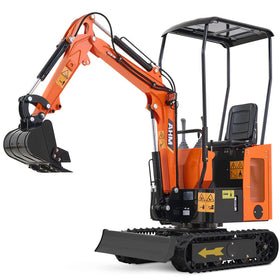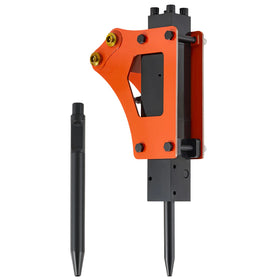Introduction

When a hydraulic auger meets concrete-hard clay soil, every construction project faces a critical challenge. Equipment strain grows, project timelines stretch, and what should be straightforward drilling threatens to become an expensive ordeal. For mini excavator operators dealing with dense clay, the difference between success and frustration often comes down to technique rather than force.
This field-tested guide breaks down four essential steps that transform tough clay soil from an immovable obstacle into a manageable challenge. Drawing from real project experiences across the clay-heavy regions of Wyoming, Texas, Georgia, and Alabama, these proven methods help maximize mini excavator auger performance while protecting valuable equipment from unnecessary wear.
After reading this, you could:
- Complete drilling jobs in half the typical time
- Prevent costly equipment damage and auger binding
- Extend attachment lifespan through proper technique
- Master methods that work across all clay soil conditions
The Clay Soil Challenge
What makes clay soil such a nightmare for equipment operators? It's not just the density - clay's unique properties can turn a routine drilling job into an equipment-straining ordeal. When dry, clay becomes harder than concrete. Add moisture, and it transforms into a sticky mass that can bind even the most powerful hydraulic auger.
Before tackling these conditions, ensure your hydraulic auger is properly installed on your mini excavator.
Not sure how to attach an auger to a mini excavator? Check our complete installation guide here. Having your attachment correctly mounted becomes crucial when dealing with clay's intense resistance and changing conditions.

Step 1: Assess and Prepare Your Drilling Site
Ask any experienced operator - the difference between smooth clay soil drilling and a day of frustration often comes down to the first five minutes of assessment. Before firing up that hydraulic auger, a quick site check saves hours of potential headaches.
Critical Checks:
- Ground hardness - press a screwdriver into the soil at marked points
- Rock presence - check for visible clusters that might damage your auger attachment
- Basic utilities marking - know what's below
- Equipment positioning - find stable, level ground for your mini digger
Quick Soil Test:
Dark, moist clay? Your hydraulic auger might cut through easier. Light-colored, dense clay? You'll need more preparation in the next step. This simple color check helps predict resistance levels and adjust your approach accordingly.
Equipment Ready-Check:
- Auger bit sharp and secured
- Mini excavator positioned vertically
- Work area cleared
- Hydraulics warmed up
For a recommended auger for your mini excavator, check out AHM's hydraulic auger drill:
That's it - no need to overcomplicate this phase. With these basics checked, you're ready to move on to the real game-changer in Step 2.
Step 2: Pre-Drill Treatment
Here's the game-changing technique most operators discover the hard way: water is your hydraulic auger's best friend in tough clay. Field experience from countless job sites proves that 5 gallons of water per hole transforms concrete-like clay into workable soil.
The Process:
Why This Works:
Clay's density drops significantly once water penetrates its structure. This simple step often means the difference between a smooth drilling operation and a stalled mini excavator auger fighting against unyielding ground.
Quick Tips:
Warning: More water isn't better. Too much creates mud that can bind your auger attachment. Stick to the proven 5-gallon mark.
Ready to start drilling? Let's move to Step 3 for the breakthrough technique.
Step 3: The Breakthrough Technique
Here's where proper technique separates smooth operation from equipment strain. After water treatment, success with your mini excavator auger comes down to one key principle: rhythm over force.
The Proven Method:
- Start with medium RPM
- Apply steady downward pressure for 10-15 seconds
- Back off for 5 seconds to clear material
- Repeat until reaching target depth
Watch For:
- Clean material evacuation
- Steady engine sound
- Consistent auger rotation
- Even breakthrough progress
Trouble Signs:
If the hydraulic auger starts binding or the mini digger strains, ease off immediately. Return to Step 2 if the clay's fighting back too hard.
Quick Tip: Let the auger attachment do the work. Fighting clay soil with more power usually leads to equipment stress and potential damage. Steady rhythm wins every time.
Ready for the final step to complete your hole efficiently? Let's move to Step 4.
Step 4: Complete the Dig
Once your mini excavator auger has established a good rhythm, completing the hole becomes straightforward. This final step focuses on maintaining efficiency while avoiding common last-minute issues that could stall your progress.
The Finishing Method:
- Keep your established rhythm
- Clear material every few feet
- Watch for changing soil conditions
- Back out slowly when done
Bottom Line: Maintaining the same steady approach that got you started works best for completion. Many operators rush this final stage - that's exactly when auger attachments tend to bind.
Quick Completion Tips:
- Don't force faster progress
- Listen to your hydraulic auger's performance
- Clear the hole completely before moving to next location
- Let the equipment cool between deep holes
With these four steps mastered, even the toughest clay soil becomes manageable for your mini excavator auger attachment. Remember: water treatment and steady rhythm beat brute force every time.
Common Issues & Regional Solutions
Clay soil conditions vary significantly across regions, affecting how effectively a mini excavator auger can perform. Understanding these regional differences and common problems helps operators adapt their drilling techniques for optimal results.
Western Clay Challenges (Wyoming, Montana): The mineral-dense clay in Western states often requires extended water absorption time, typically 25 minutes instead of the standard 15. Operators using auger attachments for mini excavators in these regions find success by applying water in two stages and maintaining slower RPM for consistent penetration.
Southern Clay Solutions (Georgia, Alabama): Southern clay's sticky composition tends to bind hydraulic augers more frequently. Successful drilling in these conditions requires reducing water application to 3-4 gallons and implementing more frequent auger clearing cycles.
Common Problems and Solutions:
When the auger attachment binds in clay soil, immediately stop operation and back out slowly. This issue typically results from excess water or material buildup around the auger flights. Clearing the auger completely before resuming operation prevents equipment damage.
Slow drilling progress often indicates insufficient water penetration in the clay soil. The solution involves returning to the water application step and allowing longer absorption time, ensuring the mini excavator auger can work through softened material effectively.
Equipment strain occurs most frequently when operators apply too much pressure too quickly. Maintaining steady rhythm and moderate pressure with the mini digger prevents unnecessary wear on both the machine and auger attachment.
TL;DR
- Western clay (WY, MT) needs 25min water soak, two rounds
- Southern clay (GA, AL) needs less water, more clearing
- Auger stuck? Stop, back out, clear material
- Too slow? Let water soak longer
- Equipment strain? Ease pressure, steady rhythm

Conclusion
Breaking tough clay soil with a mini excavator auger doesn't have to be a constant battle. When you combine proper water treatment, steady rhythm, and regional know-how, even concrete-hard clay becomes manageable. No matter how tough the soil seems, remember that rushing or forcing your hydraulic auger only leads to equipment strain and project delays.
Equipment Check: Take five minutes post-job to inspect your auger attachment. This quick check prevents minor wear from major repairs.
(Dealing with other difficult ground conditions? Check out our guide on how to dig holes in hard soil for more specialized techniques.)
Simple steps, proven results. Now you're ready to tackle that clay soil project with confidence.







